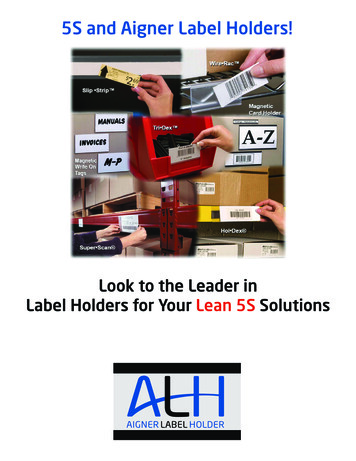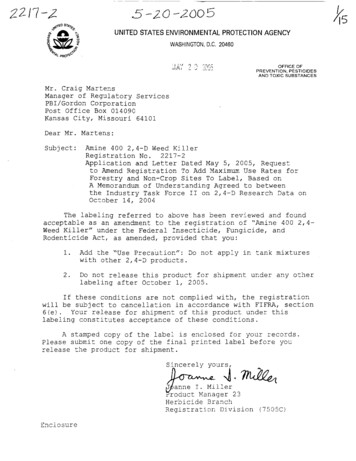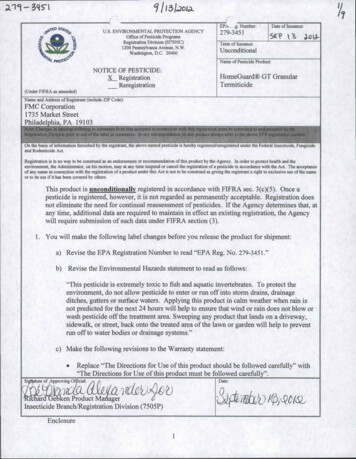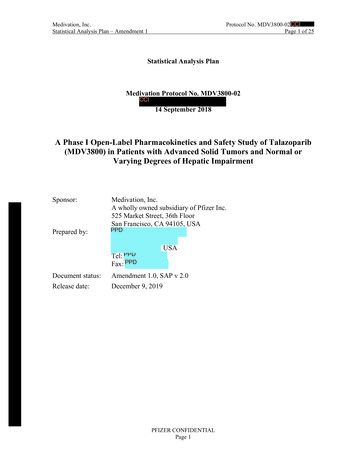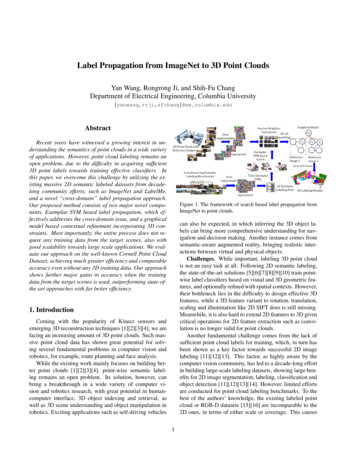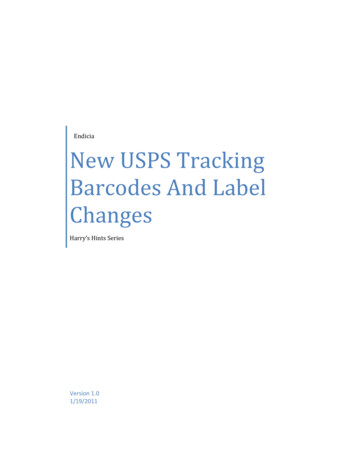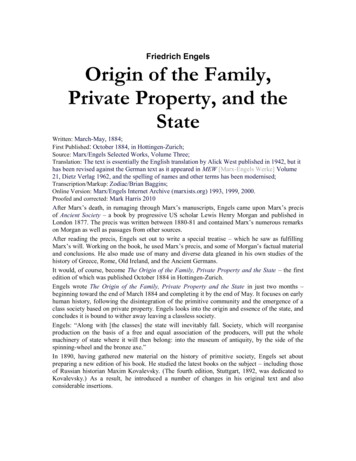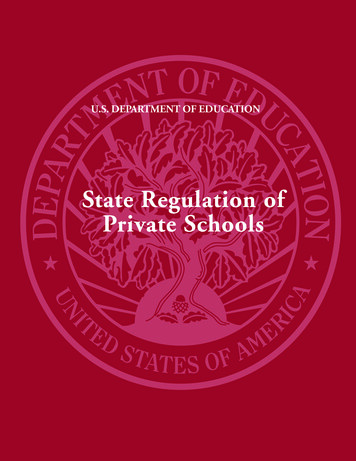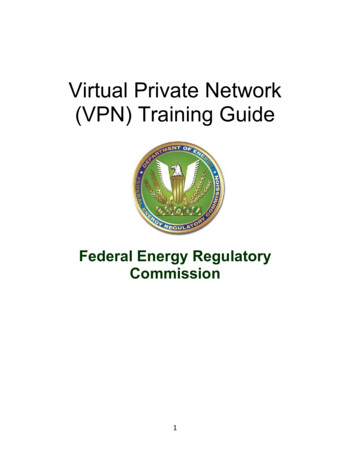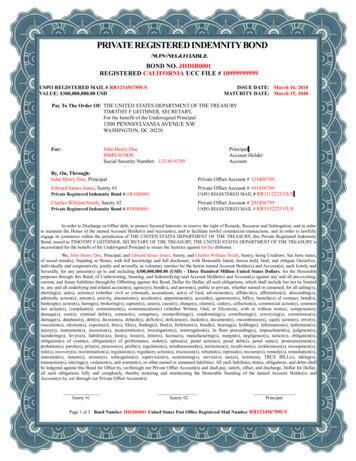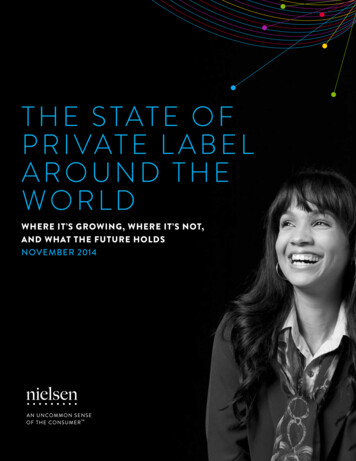
Transcription
T H E S TAT E O FP R I VAT E L A B E LAROUND THEWORLDWHERE IT’S GROWING, WHERE IT’S NOT,AND WHAT THE FUTURE HOLDSNOVEMBER 2014Copyright 2014 The Nielsen Company1
CONTENTSINTRODUCTION / SURVEYMETHODOLOGY. 4PART I: THE PRIVATE L ABELBRAND REL ATIONSHIP. . .7A win/win situation for both name brands and private label. 8When brands win: Hair care . . .10When private label wins: Milk. 11The assortment challenge. 12PART II: REGIONAL ROUNDUP. 14Developed regions. 14Europe. 15North America. 17The Pacific. 20Private-label growth drivers in developed markets. 22Developing regions. 24Asia.25Special focus on India.27Latin America. 28Africa/Middle East. 302THE STATE OF PRIVATE LABEL AROUND THE WORLD
PRIVATE L ABEL:YOU’VE COME ALONG WAY, BABYAROUND THE WORLDPerceptions about private-label brands arefavorable around the world, but value shares arenot correspondingly distributed; they are muchhigher in developed regions like Europe, NorthAmerica and Australia.Private-label success is strongest in commoditydriven, high-purchase categories and those whereconsumers perceive little differentiation.Private-label growth typically comes at the expenseof small- and mid-sized brands, while categoryleaders remain relatively safe.Retail consolidation and the expansion of thediscount format are key drivers for private-labelgrowth in developed markets.Private label struggles to gain consumer trust inAsia and the Middle East, where consumers arefiercely brand-loyal.Copyright 2014 The Nielsen Company3
Long gone are the days of no-frills packaging intended only for thoseon a tight budget—private label, also known as store brands, are nolonger viewed simply as low-cost alternatives to name brands; they’reincreasingly high-quality products that fulfill consumer needs across avariety of price points.Shoppers have taken notice of this shift and are responding positively.Today, perceptions about private label are overwhelmingly favorable—almost three-quarters of global respondents (71%) say private-labelquality has improved over time. A door once opened by economicnecessity has widened to include a variety of private-label products thatremain viable and trusted for many consumers worldwide.To understand current consumer perceptions about private-labelquality, value, assortment and packaging, Nielsen polled more than30,000 online consumers in 60 countries. A few shared sentimentsemerged around the world: Price is important to most consumers and is the primary driver ofconsumers’ purchase intent for private label. Sixty-nine percentof respondents globally feel it’s important to get the best price ona product. Moreover, 70% say they purchase private label to savemoney.Private label’s appeal goes beyond price. Consumers are seekingquality and value, and private label delivers on both of theseattributes. Two-thirds (67%) believe private label offers extremelygood value for money, and 62% say buying private label makesthem feel like a smart shopper.ABOUT THE GLOBAL SURVEYMETHODOLOGYThe findings in this survey are basedon respondents with online access in60 countries. While an online surveymethodology allows for tremendousscale and global reach, it providesa perspective only on the habits ofexisting Internet users, not totalpopulations. In developing marketswhere online penetration is stillgrowing, audiences may be youngerand more affluent than the generalpopulation of that country. In addition,survey responses are based on claimedbehavior rather than actual metereddata.The survey research is supplementedwith actual behavior using Nielsen’sretail and consumer purchase data.But do these enthusiastic attitudes translate into sales? The answerdepends on the market. In terms of private-label development, theworld can be divided into two distinct spheres: the developed world(Europe, North America and the Pacific) and the developing world(Latin America, Asia and Africa/Middle East). While value share is at orabove 15% in developed regions (and as high as 45% in Europe), it isbelow 10% in most developing countries in the study. In fact, it is 5%or less in key markets, such as China, India and Brazil.While learnings about private-label success in one market can help inanother, there is no cookie-cutter approach for all. Private-label growthrequires approaches that are tailored to each market. In this report,we highlight the current state of private-label development aroundthe world, the drivers and obstacles to success and the impact thesebrands have on name-brand performance.4THE STATE OF PRIVATE LABEL AROUND THE WORLD
POSITIVE PERCEPTIONS FOR PRIVATE L ABEL ARE SHAREDACROSS THE GLOBEPERCENT OF RESPONDENTS WHO SOMEWHAT OR STRONGLY AGREESource: Nielsen Global Survey of Private Label, Q1 2014Copyright 2014 The Nielsen Company5
PRIVATE-L ABEL DEVELOPMENT VARIES DRAMATICALLYAROUND THE WORLDDOLL AR SHARE BY COUNTRY16.5%WEIGHTEDGLOBAL AVERAGE16.5%EUROPEASIA-PACIFICL ATIN AMERICAMIDDLE EAST / AFRICANORTH AMERICASource: Nielsen; 2013 for most countries* Indicates 2014 YTD** Indicates 2014 MATNote: For a consistent cross-country view, all categories areweighted equally to produce an average private-label share.Individual country reporting may vary due to reporting differences.6THE STATE OF PRIVATE LABEL AROUND THE WORLD
PART I:THE PRIVATEL ABEL-BRANDREL ATIONSHIPCopyright 2014 The Nielsen Company7
A WIN/WINSITUATION—FOR BOTH NAMEBRANDS ANDPRIVATE L ABELAcross the globe, private-label sales and shares are strongest incommodity-driven, high-purchase categories and those whereconsumers perceive little differentiation, such as paper products andsome medications and remedies like aspirin. But the definition of acommodity varies greatly across the world. In developed markets like theU.S., Europe and Australia, this includes products such as milk, breadand eggs. In India, however, commodities include products that aredistinctly local, such as ghee, rice, and atta flour used to make bread.While some commonalities exist, the categories where private-labelmarket shares are strongest vary dramatically by country. Even in themost-developed European markets, where one might expect similarpurchasing habits across countries, big differences exist in private-labeland name-brand performance for each category by country.8THE STATE OF PRIVATE LABEL AROUND THE WORLD
PRIVATE-L ABEL PERFORMANCE DIFFERS BY COUNTRY AND BY CATEGORYYEAR-OVER-YEAR SALES CHANGE BY CATEGORY FORSELECT EUROPEAN COUNTRIESALCOHOLICBEVERAGESBABYCARECONFECTIONERY& SNACKSPRIVATE L 0.4%6.3%0.5%3.0%Source: NielsenYear-over-year sales change (August 2012 - July 2013 and August 2013 - July 2014)Copyright 2014 The Nielsen Company9
WHEN BRANDSWIN: HAIR CAREThough hair-care category share varies by country, name brandsconsistently outperform private label in the category. In the U.S., only2% of hair-care sales (as of September 2014) come from private-labelbrands.What makes it so difficult for private label to break into the hair-caremarket? The category has several distinct elements that favor namebrands:110 High innovation rate—New products launched within one yearmake up more than 4% of same- year total category sales. Launchesin this category are big (generally millions of dollars in sales) andrequire significant investment, which makes it more difficult forprivate label to compete. High product differentiation—Manufacturers have developedproducts to serve a wide array of needs, including anti-dandruff,color protection and damage repair, among others. The degree ofreal and perceived differentiation is extremely high. Strong marketing support—Marketing spend is incredibly high inthis category. In 2012, name-brand manufacturers spent around 6.8billion on personal care products.1 Strong brand equity—Name-brand manufacturers’ investments ininnovation and marketing has created strong brand preferences andloyalty among consumers. Globally, more than one-third (35%) ofrespondents in Nielsen’s survey say they are willing to spend morethan the average price on shampoo because it’s worth paying extra.It is among the top three products for which consumers are willingto pay a premium in every region. Longer purchase cycle and heavy promotional activity—Consumerspurchase hair-care items less frequently than some other FMCGcategories (such as edibles). Since purchasing is more sporadic, thehigher price tag for brands is less of a barrier. In addition, hair-careproducts are often heavily promoted, lowering the price differentialbetween name-brand and private-label products.According to AdAge estimatesTHE STATE OF PRIVATE LABEL AROUND THE WORLD
WHEN PRIVATEL ABEL WINS: MILKShare for milk varies by country, but private label often represents 40% ormore of total sales in developed markets.Why are name brands finding it tougher to compete with private labelin the milk market? The category has several distinct features that favorprivate-label brands: Minimal differentiation and low brand equity—Perceived differencesamong milk products are low. There are many suppliers, and it is easierfor private label to create “me too” products (at lower cost) in thiscategory. Interestingly, the “Got Milk?” advertising campaign—themost successful in the category—was not branded. High price sensitivity and high purchase frequency—Consumersare highly sensitive to price. In developed markets, milk is a lowinvolvement, low-risk purchase. Consumers are less brand-loyal andlook for the best price. Switching costs are low. In addition, milkhas a fast purchase cycle, making its price more noticeable to mostconsumers. In the U.S., the average branded milk product cost 3.16,while the average private-label milk product costs 3. Low innovation rate—Name brands have done very little to innovate inthe milk category. In general, innovation is less common in commoditycategories, and new products represent less than 0.5% of same yearsales.While milk is a commodity product in developed markets, it hasn’tachieved the same status in many developing markets. More than 40% ofrespondents in Latin America (43%), Asia Pacific (41%) and Africa/MiddleEast (41%) are willing to pay more than average for milk because theythink it is worth it, compared to 25% in Europe and 19% in the U.S. This isa category with strong private-label growth potential in some developingmarkets given the size and penetration of the category globally, as well asthe strong private-label sales we’ve seen in more mature markets. Successdepends, however, on retailers’ ability to convince consumers that theirproduct is of comparable quality to leading name brands.It is also important to recognize that while private label holds very highshares in traditional commodity-driven products like milk, sales growthis slow as consumer demand saturates. Additional opportunities existfor retailers that look beyond commodity categories and move into eitherhigher growth categories or those categories where private-label share isrelatively low today.Copyright 2014 The Nielsen Company11
THE ASSORTMENTCHALLENGEPrivate-label growth is partially driven by what’s available on storeshelves; that is, it’s an offer-driven market. Globally, nearly six in 10 (59%)respondents agree they would buy more private label if a larger variety ofproducts were available. It is a misconception, however, that increasingthe breadth of assortment will automatically drive sales. Retailers mustpursue the right selection, not just a bigger selection. Consequently,necessary delisting decisions should be taken with great care.Replacing name brands that are declining in share with private-labelproducts that deliver better margins usually comes at the expense ofsmall- and mid-sized name brands. Typically, category leaders are notchallenged by private-label cannibalization; rather, the number two andthree brands often face the greatest threat to sales. For example, in theU.K. today, on average, 40% of sales come from the category leader, 41%from private label and 19% from all other brands. In the U.S., where theretail market is more fragmented, 31% of sales come from the leader,17% from private label and 52% from all others. Retailers must managetheir shelf space carefully. Removing too many high-penetration, highfrequency or strong niche brands from store shelves can drive shoppersto the competition.So how many private-label brands are optimal? It depends on the marketand the category. In the U.S. and Europe, consumers are more acceptingof private-label products and, therefore, their comfort threshold islower: only one-third of North American (33%) and European (35%)respondents believe retailers have too many private-label brands on theshelf. In developing markets, where the number of private-label brandsis significantly less and the comfort threshold is higher, more consumersfeel there are too many private-label brands on retailer shelves (50%in Asia Pacific, 60% in Africa/Middle East and 54% in Latin America).Correspondingly, more than half of respondents in developing marketsalso think retailers have eliminated too many name-brand products,driving them to shop in multiple stores.IT IS AMISCONCEPTIONTHAT INCREASINGTHE BREADTH OFASSORTMENT WILLAUTOMATICALLYDRIVE SALES.To determine an optimal assortment strategy, a keen understanding ofmarket dynamics and consumer consumption patterns is necessary.While the right assortment varies by market, one factor is critical for allconsumers: Consumers want to comparison-shop. Nearly three-quarters(73%) of global respondents prefer to see name-brand and private-labelitems next to each other on the store shelf so they can easily reviewprices.12THE STATE OF PRIVATE LABEL AROUND THE WORLD
ASSORTMENT STRATEGIES DIFFER DEPENDING ON THE REGIONPERCENT OF RESPONDENTS WHO SOMEWHAT ORSTRONGLY AGREESource: Nielsen Global Survey of Private Label, Q1 2014Copyright 2014 The Nielsen Company13
PART IIREGIONALROUND-UPDEVELOPEDCOUNTRIES14THE STATE OF PRIVATE LABEL AROUND THE WORLD
EUROPE: THEPRIVATE L ABELLEADERPrivate label is most developed in Europe, particularly in the Westernmarkets. Private label accounts for 1 of every 3 spent in the consumerpackaged goods (CPG) market. Switzerland has the highest private-labelshare (in the region and around the world) at 45%, followed closelyby the U.K. and Spain at 41% each. Private label is less developed ineastern and central Europe, where share varies greatly from a high of24% in Poland to a low of 5% in Ukraine.Private label has become an essential staple in consumers’ shoppingbaskets and perceptions are overwhelmingly positive in the region.Seventy percent of European respondents believe private label is a goodalternative to name brands and 69% believe they offer good value for themoney. Just under one-third (30%) believe private label is not reliablewhen quality matters.Europe provides a strong model for how retailers can successfullydevelop and grow private-label brands. The region’s successful privatelabel retailers have invested in brand management activities like thoseof their manufacturer peers, building significant brand equity andrecognition for their products by providing value with standard andpremium offerings for consumers at all price points. Importantly, theyare also innovating to address unmet consumer needs.That said, Europe also illustrates some important truths for name-brandmanufacturers. Most importantly, private label does not represent thedemise of name brands. Share of basket for even the heaviest privatelabel buyers hits a tipping point around 50%, and the most developedmarkets are at saturation levels. Private-label share in Switzerland andthe U.K. has remained around 45% for the past 10 years.“Private label by nature is not predestined to grow; name brands havethe growth advantage,” said Jean-Jacques Vandenheede, director of retailindustry insight, Nielsen. “Commitment to innovation, analytics andmarketing are effective strategies for maintaining and growing share.Aggressive promotional activity, as we’ve seen in the U.K., can also helpcap the growth of private label, but such reactive price measures are notsustainable in the long term.”PRIVATE-LABEL SHAREINCREASED IN MOST EUROPEANCOUNTRIESPRIVATE-LABEL DOLLAR SHARECHANGEFROM2009INCREASEDECREASE2013NO CHANGE-145% Switzerland 1041% Spain-241% United Kingdom 234% Germany 833% Portugal 330% Belgium 129% Austria028% France 227% Netherlands 325% Denmark 325% Sweden 424% Hungary 1024% Poland-222% Czech Republic 322% Finland-822% Slovakia 121% Norway 217% Italy 416% Greece 214% 16% TurkeyRussiaSource: NielsenCopyright 2014 The Nielsen Company15
So price is not an irresistible differentiator. Psychological factors can beimmensely powerful. Shoppers will not compromise in some categories.For example, private label has not made a sizeable impact in the healthand beauty category despite a price advantage of approximately 40%.Moreover, even in the hardest of times, consumers crave occasionalindulgences, and they will pay a premium for their favorite brands.WINNING STRATEGIES INVEST IN MARKETING ACTIVITIES TO BUILDPRIVATE-L ABEL EQUIT Y. OFFER PREMIUM AND STANDARD PRICE TIERS. INNOVATE TO MEET CONSUMER NEEDS.PRIVATE-L ABEL VALUE PERCEPTIONS OUTPERFORM QUALIT Y IN MOSTOF EUROPE, BUT SENTIMENTS ARE HIGH FOR BOTHPERCENT OF RESPONDENTS WHO SOMEWHAT OR STRONGLY AGREESource: Nielsen Global Survey of Private Label, Q1 201416THE STATE OF PRIVATE LABEL AROUND THE WORLD
NORTH AMERICA:POSITIVEPRIVATE-L ABELPERCEPTIONSBUT STAGNANTGROWTHWith dollar shares of 17.5% in the U.S. and 18.4% in Canada, NorthAmerican private label is just above the average global share of 16.5%.Since the recession ended, growth of private-label brands in the U.S. hasbeen fairly flat as name brands stepped up both promotional activityand innovation efforts to protect share positions and to drive growth.The country’s private-label share increased only 1.3 percentage pointsbetween 2009 and 2013. In Canada, private-label share has also beenstagnant because shoppers have increasingly turned to promotionsto save and name brands drove more sales through savvy pricingstrategies.The social stigma of private label has virtually disappeared in the region.The majority of shoppers are pleased with private-label products, callingthem a good alternative to name brands (75% of Americans, 73% ofCanadians), a good value (74% of Americans, 66% of Canadians)and at parity with name brands on quality (67% of Americans, 61% ofCanadians).“To drive increased private-label growth, retailer focus and commitmentwill be critical,” said Todd Hale, former senior vice president andcurrent consultant, consumer and shopper insights, Nielsen. “Best ofbreed retailers win by using a combination of organizational focus andoperational excellence, and by ensuring they offer the right product atthe right pri
necessity has widened to include a variety of private-label products that remain viable and trusted for many consumers worldwide. To understand current consumer perceptions about private-label quality, value, assortment and packaging, Nielsen polled more than 30,000 online consumers in 60 cou

